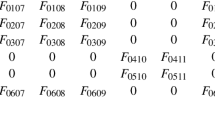Abstract
In this paper, we present a formulation of state variable based gradient theory to model damage evolution and alleviate numerical instability associated within the post-bifurcation regime. This proposed theory is developed using basic microforce balance laws and appropriate state variables within a consistent thermodynamic framework. The proposed theory provides a strong coupling and consistent framework to prescribe energy storage and dissipation associated with internal damage. Moreover, the temporal evolution equation derived here naturally shows the effect of damage—nucleation, growth and coalescence. In addition, the theoretical framework presented here is easily extendable to the addition of other defects (not shown here), and can be generalized to the development of consistent coupled transport equations for species, such as hydrogen (Bammann et al. in JMPS, 2009, submitted), as well as providing a consistent structure for modeling events at diverse length scales.
Similar content being viewed by others
References
Bammann, D.J., Novak, P., Sofronis, P., Somerday, B.: A coupled dislocation-hydrogen based model of inelastic deformation of metals and alloys. JMPS (2009, submitted)
Cosserat E., Cosserat F.: Theorie des corps deformables. Hermann et Fils, Paris (1909)
Dillon O.W., Kratochvil J.: A strain gradient theory of plasticity. Int. J. Solids Struct. 6, 1533–1566 (1970)
Nunziato J.W., Cowin S.C.: Non-linear theory of elastic-materials with voids. Arch. Ration. Mech. Anal. 72(2), 175–201 (1979)
Bammann, D.J., Aifantis, E.C.: On the perfect lattice-dislocated state interaction. In: Selvadurai, A.P.S. (ed.) Mechanics of Structured Media. In: Proceedings of the International Symposium on the Mechanical Behaviour of Structured Media, Ottawa, pp. 79–91 (1981)
Bammann D.J., Aifantis E.C.: On a proposal for a continuum with microstructure. Acta Mech. 45(1–2), 91–121 (1982)
Aifantis E.C.: On the microstructural origin of certain inelastic models. Trans. ASME J. Eng. Mater. Technol. 95, 215–229 (1984)
Bammann D.J.: An internal variable model of visco-plasticity. Int. J. Eng. Sci. 22, 1041–1053 (1984)
Brown S.B., Kim K.H., Anand L.: An internal variable constitutive model for hot-working of metals. Int. J. Plast. 5(2), 95–130 (1989)
McDowell D.L.: A bounding surface theory for cyclic thermoplasticity. J. Eng. Mater. Technol. Trans. ASME 114(3), 297–303 (1992)
Zbib H.M., Aifantis E.C.: On the gradient-dependent theory of plasticity and shear banding. Acta Mech. 92, 209–225 (1992)
Fleck N.A., Hutchinson J.W.: A phenomenological theory for strain gradient effects in plasticity. J. Mech. Phys. Solids 30, 1825–1857 (1993)
Tvergaard V., Needleman A.: Effects of nonlocal damage in porous plastic solids. Int. J. Solids Struct. 32(8–9), 1063–1077 (1995)
Gurtin M.: Generalized Ginzburg–Landau and Cahn–Hilliard equations based on a microforce balance. Physica D 92, 178–192 (1996)
Nix W.D., Gao H.J.: Indentation size effects in crystalline materials: a law for strain gradient plasticity. J. Mech. Phys. Solids 46(3), 411–425 (1998)
Ramaswamy S., Aravas N.: Finite-element implementation of gradient plasticity models: Part I: gradient-dependent yield functions. Comput. Methods Appl. Mech. Eng. 163(1–4), 11–32 (1998)
Gurtin M.: On the plasticity of single crystals: free energy, microforces, plastic-strain gradients. JMPS 48, 989–1036 (2000)
Regueiro R.A., Bammann D.J., Marin E.B., Garikipati V.: A nonlocal phenomenological anisotropic finite deformation plasticity model accounting for dislocation defects. J. Eng. Mater. Technol. Trans. ASME 124, 380–387 (2002)
Hutchinson J.W.: Plasticity at the micron scale. Int. J. Solids Struct. 37, 225–238 (2000)
Clayton J.D., McDowell D.L, Bammann D.J.: A multiscale gradient theory for single crystalline elastoviscoplasticity. Int. J. Eng. Sci. 42, 427–457 (2004)
Bammann, D.J., Solanki, K.N.: On kinematic, thermodynamic and coupling of a damage theory for polycrystalline material. IJP (2009, submitted)
Coleman B.D., Noll W.: The thermodynamics of elastic materials with heat conduction and viscosity. Arch. Ration. Mech. Anal. 13, 167–178 (1963)
Fried E., Gurtin M.E.: Continuum theory of thermally induced phase transitions based on an order parameter. Physica D 68, 326–343 (1993)
Kachanov M.: Time of the rupture process under creep conditions. Izv. Akad. Nauk. USSR Otdelenie Tech. Nauk 8, 26–31 (1958)
Bammann D.J.: A model of crystal plasticity containing a natural length scale. Math. Sci. Eng. A309–A310, 406–410 (2001)
Author information
Authors and Affiliations
Corresponding author
Rights and permissions
About this article
Cite this article
Solanki, K.N., Bammann, D.J. A thermodynamic framework for a gradient theory of continuum damage. Acta Mech 213, 27–38 (2010). https://doi.org/10.1007/s00707-009-0200-5
Received:
Revised:
Published:
Issue Date:
DOI: https://doi.org/10.1007/s00707-009-0200-5




